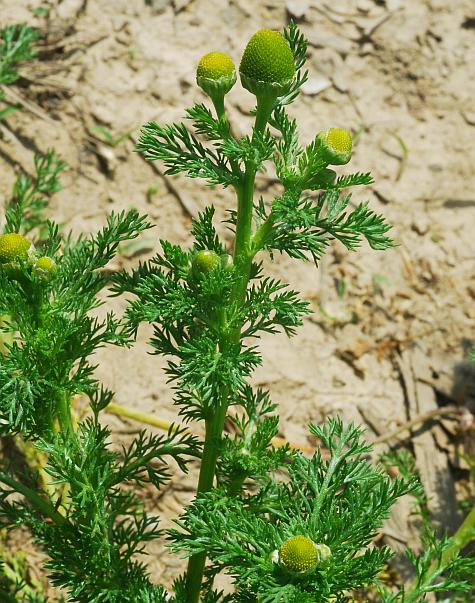Matricaria discoidea DC.
Pineapple Weed

Introduced
CC = *
CW = 3
MOC = 67
© SRTurner
Matricaria discoidea DC.Pineapple Weed | |
 |
Introduced CC = * CW = 3 MOC = 67 |
© SRTurner |
|
Family - Asteraceae/Anthemideae Habit - Taprooted annual forb, with an often strong odor of pineapple when bruised. Stems - Ascending, to 30 cm, often multiple from base, usually branched, glabrous or with a few sparse hairs.
Leaves - Alternate, sessile to very short petiolate below. Blades 1-3 cm long, elliptic to oblong-obovate in outline, mostly deeply 2 times pinnately lobed, the basal primary lobes usually well spaced and not appearing clustered, the ultimate lobes 2-10 mm long, linear to threadlike, 1-veined.
Inflorescence - Loose terminal clusters of flowering heads, the stalks glabrous or minutely hairy, bractless.
Heads - Discoid, globose to ovoid, to 8 mm in diameter, the florets numerous, the stalks 0.3-1.2 cm long, relatively stout. Involucre 2.5-4.0 mm long, the bracts in 2-3 loosely overlappping series, subequal, elliptic-lanceolate to oblong, rounded or angled to a minute, sharp point at the tip, glabrous or sparsely and minutely hairy, green when young but soon becoming tan to straw-colored, the midrib not keeled, green to reddish brown and often somewhat glandular. Receptacle strongly convex to conical, elongating with maturity, hollow, naked.
Florets - Ray florets absent. Disc florets with the corolla 1.0-1.5 mm long, mostly 4-lobed, greenish yellow. Pappus absent or a minute collar (to 0.1 mm long).
Fruits - Achenes 0.9-1.2 mm long, 3-5-ribbed, the ribs often relatively small. Flowering - May - October. Habitat - Fields, pastures, barnyards, railroads, roadsides, open disturbed areas. Origin - Native to the western U.S., introduced in many parts of the U.S. Lookalikes - None. Other info. - This small species is common throughout most of Missouri, and is found in most of the continental U.S. except for southern regions. It is easy to identify on by general appearance, with its frilly foliage and globose, yellow-green heads. Crushing a bit of foliage or a flowering head will release a strong pineapple scent, which is a characteristic unique to this species. The plant is adapted to highly disturbed areas and will often be found growing areas such as paths and sidewalk cracks. Photographs taken at Taberville Prairie, MO., 6-7-03 (DETenaglia); also at Pacific Palisades Conservation Area, Jefferson County, MO, 4-25-2016 (SRTurner). |